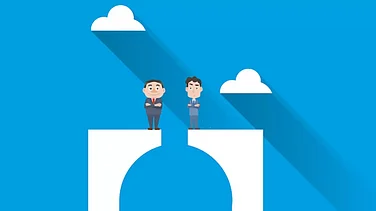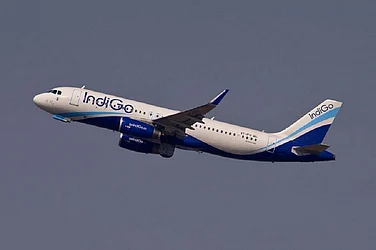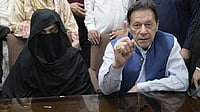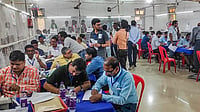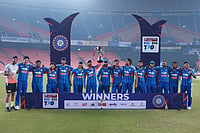FOR tens of millions of Indians, debt is no longer a four-letter word. Rather, for these feverishly consumerist wannabes, it's a many-splendoured thing. While public debt—what the Indian Government owes the nation and the world—teeters at a stupefying 75 per cent of our Gross National Product, a massive number of Indians, cutting across all income and demographic classes, may be entering their own private debt traps.
Try talking to 26-year-old Ganesh Lakshmanan, Bombay-based entrepreneur and proud possessor of four credit cards and one charge card, about Bimal Roy's classic Do Bigha Zameen, which, by chronicling the life and debt of a marginal farmer, remains the definitive distillation of traditional Indian attitudes towards being in the red. Try mentioning Mother India—or, for that matter, countless other films where the village moneylender is the epitome of all things evil and despicable—to thirty something Akash Dyes, Delhi-based executive in a courier company, who has managed an outstanding of over Rs 18,000 on his eight-month-old Standard Chartered Card. Or, on second thoughts, don't try.
"I use credit whenever and wherever I can. I look for places that use cards. This way, I can buy whatever I want even if I don't have the cash right away," says Lakshmanan. Dyes admits his outstandings are far above his current ability to repay. But he isn't worried. "I make purchases worth Rs 5,000 to Rs 10,000 every month and I only repay the minimum amount each time," he explains. He's just booked the Rs 3 lakh plus Fiat Uno, using his card to pay the booking amount. Since he pays just the minimum amount each time, he has to pay a 2.5 per cent per month (that's 30 per cent a year!) interest surcharge on his outstandings, which are rising all the time. He isn't too concerned. "I never look at the interest amount when I get the monthly statement," he says with an air of bravado.
Dyes and Lakshmanan represent the tidal wave force with which the 'buy now, pay later' culture is taking over. A culture that buys six out of every 10 cars it purchases on card. Which provides card marketers like Standard Chartered with 1.8 lakh card-holders in two years. A way of life that, like nuclear power, has no inherent flaw but which, in the hands of the wrong people, can cause tremendous harm. The untrammelled consumer borrowing of the Reagan years hinged on the logic that growth would be sustained indefinitely and everyone would earn more and more each passing year, enough to service the debts. The result: the collapse of the American savings and loan (S&L) industry—and countless individual bankruptcies—at the first sign of economic recession, and a recession compounded manifold.
Of course, the direst Cassandra will not predict that the Indian personal debt problem is anywhere close to American, European or even South-east Asian levels. No undisputed figures are available for the common Indian's debt level, but a glance around any large city (and a probe into small-town India too; see box) gives a clear indication of the pace and scale at which things are changing. And history repeats itself—it repeats itself in India five to six years after it's happened in the US. The securities scam and the junk-bond-led Wall Street crash of 1987, the satellite TV boom, anything else you can think of. "Right now, debt is fashionable," says Rajesh Srivastava, general marketing manager, Herbertsons. "People today are proud to live in debt. Salaries have gone up just for a few managers. People want to emulate dream lifestyles and find the debt route meeting their needs perfectly."
"Yes, my parents are conservative. If they know just how much I live on credit, they'll be stunned," admits Lakshmanan. The syn-drome, says R.N. Sharma of the Tata Institute of Social Sciences, points to "a rebellious attitude that's negating traditional values. There are no responsibilities, carelessness is imbedded in it."
Consumer credit in the organised sector began in the mid-'70s, till which time it was all chit funds and moneylenders. But it was only a decade later, with Rajiv Gandhi's brand of liberalisation, that consumer finance became the buzzword, and almost major business groups, from the Tatas to ITC, jumped in. "Rajiv Gandhi delicenced many industries and also introduced broadbanding. Earlier, two separate licences were needed to produce mopeds and scooters. But due to broadbanding, a licence to produce two-wheelers of any kind was given," says S.L. Rao, former director-general of the National Council of Applied Economic Research (NCAER). The resultant spurt in production changed the way trading cycles operated. Earlier, consumers chased manufacturers, but now with supply exceeding demand, manufacturers chased consumers.
In many cases, these consumers had to be created rapidly to expand the markets, and credit was the easiest way to do so. Citibank led the charge with its Consumer Services Group. When last year, Onida and ICRA launched ONICRA, a personal credit rating company, it was a clear signal to those who paid attention that consumers may have just jumped a couple of steps in the ladder to enter a new stage of evolution.
Today, the boom is driven by companies like Countrywide Consumer Financial Services, a joint venture between the Housing Development Finance Corporation (HDFC) and the US-based GE Capital. The company set up operations exactly two years ago with an equity investment of $10 million and specialises in financing consumer durables, two-wheelers and automobiles. Among its innovative products that have greased the route to quick 'n' easy credit: SKIP—a 'buy-in-1995 and pay-in-1996' concept which was introduced during the festive season, where you began paying back your loans only three months after purchase. The company partners most of India's leading consumer durables manufacturers like BPL, Godrej-General Electric, HCL-HP, LML, Onida, Panasonic and Philips. Just last week it joined hands with the country's leading automobile manufacturer, Maruti Udyog Limited, to form Maruti Countrywide, India's first captive auto finance company. In just two years, Countrywide has already disbursed loans worth Rs 405 crore to 42,000 customers. Of this, auto finance accounts for Rs 130 crore and 8,500 customers.
Naturally, there are many who feel all this is good for the economy. "All developing countries have to be debt-driven. Productivity or efficiency-enhancing possessions like computers sustain a pattern of growth," says Ramesh Panicker, associate vice-president, Lloyds Finance. His theory: purchase of such goods increases return on investment because you progress professionally and earn more. And it's this expectation of earning more in the future that drives most credit purchases. "The last few years have seen an unprecedented boom as far as certain income classes are concerned, and they believe the boom will continue for some more years at least, that is, there are people who believe their incomes will keep on rising every year, so they will be able to service their loans. If their incomes don't rise, they will have a major problem on their hands," says a foreign bank executive dealing in consumer finance.
Kailash Gupta of Divya Electronics, a big electronics and white goods outlet in east Delhi, says over 50 per cent of his sales are on credit, roughly equally divided between financing schemes and credit cards, which he admits have had a major impact over the last few years. He attributes this to the fact that there's no down payment needed on purchases through cards. India currently has about two million card-users, almost 50 per cent of whom signed up in the last two years. Clearly, in neo-consumerist India, anything sufficiently marketed, succeeds. But the growth of the credit card market is due more to competition among banks than anything else. Attractive incentives include holidays abroad, free gifts, even cruises. Standard Chartered Bank even offers to repay your amount outstanding on a Citibank credit card if you switch. Of course, you've got to repay Stanchart later.
Marketers are already eyeing nascent target segments, selling cards to rich kids in urban colleges, and MBA students about to graduate. So theoretically, by the time you earn your first salary, you may actually have already spent it several times over. Vijay Raghunathan, manager-sales (north), Standard Chartered Bank, expects the number of card-holders to increase tenfold by the year 2000. "The first appearance of plastic money in India was about 30 years ago. But awareness has risen by leaps and bounds only after they were aggressively marketed over the last two years," says he.
Buddha Bandopadhyay, 49, a sarkari geologist whose monthly income doesn't exceed Rs 10,000, is a beneficiary—or victim. "I got a card because it would enable me to buy things which I am otherwise unable to afford. For government servants like me, with a limited income and fixed time increments, this is a boon," he says. Despite the higher interest rate he pays, he prefers it to hire-purchase schemes because of the cumbersome procedures, paperwork and guarantees involved. "Hassle-free buying power," he calls it. But a senior foreign bank executive warns that interest rates on credit card out standings touch 32-34 per cent a year, but most customers don't notice that because the absolute amount of the interest which appears on the monthly bill, usually disguised as innocuous 'service charges', seems quite small.
Currently, major usage of cards is still restricted to the top 10 cities. And despite the boom there are still some like Ray Galliott, manager, card products division, Hongkong Bank, who are unsatisfied. Says he: "Credit buying is still insignificant in India. Against 13 million credit cards in China there are less than 2 mil-lion in India. It should have been 6 million." Concurs Rao: "Credit cards apart, consumer finance is still concentrated in the metros. In the small towns, there's little finance available." An NCAER study pointed out that in smaller towns the most commonly financed article was the bicycle. And only 10 per cent of the total bicycles purchased were financed.
But it's filtering down sooner than expected. Kotak Mahindra Auto Finance already has 22 offices, and has plans for more. Maruti Countrywide will be in 12 cities by the year-end. And for financing in small towns and the hinterland, finance companies file documents with their city offices which prevents a true picture from emerging. A recent NCAER survey, for instance, pointed out that when one considers households in the lowest income level (annual income below Rs 12,500), 40 per cent and above own portable radios, mechanical wrist-watches and bicycles. Besides, between 30 and 39 per cent own table fans and 20-29 per cent own cassette recorders, black-and-white TV sets, electric irons and ceiling fans. And 10-19 per cent own motorcycles, mopeds, colour TVs and mixer-grinders.
Says Rajinder Sawhney, proprietor of Arvee Enterprises, an electronic goods showroom in Delhi: "In the low-income underdeveloped market, debt takes the form of delaying payments by buying goods on instalments. In low-income colonies, 50 per cent of our sales are through finance schemes." Move slightly up the income scale, to the salaried clerical class, who purchase 50 per cent of their white goods and consumer electronics on credit. "It's this mass of people at the clerical level who get hurt the most," says a consumer finance executive. "They borrow from fairly informal sources at usurious rates, and the instalments really eat into their real income."
Adds Srivastava of Herbertsons: "This excessive spending doesn't have the safety net of the social security system beneath it as in the US. Neither is the Indian counterpart—the joint family—holding ground. This makes the issue grim." And despite the safety net, the situation is pretty grim in the US too. With 16 per cent of all consumer purchases being made through cards, overall consumer debt has surged by 39 per cent in the last five years and now totals $1 trillion (Rs 35,00,000 crore), with the average household outstanding touching $ 4,800, up from $ 2,340 five years ago. This huge debt forced 4.25 per cent of credit card loans to be written off as losses last year and personal bankruptcies rose by 6 per cent.
Such statistics could worry card junkies like Bombay-based Isith Gangooly, 26, regional manager with a shipping company, with an annual income of Rs 1.5 lakh. "My outstanding is around Rs 17,000-18,000 a month (which is way above his monthly income). My parents would be horrified. I don't feel I need all the things I spend on, but Bombay society makes a lot of demands on you," he explains.
Adds Lakshmanan: "Yes, I spend a lot more than I could have afforded if I had to pay in cash for everything. But it is worth the lifestyle I can live now. I believe you should spend till you can afford and I have become extremely dependent on credit cards." And yes, he revolves credit, paying the minimum amount each time, because that's all he can afford. For Lakshmanan, Gangooly, Dyes and their ilk, the phrase 'buy now, pay later' may take on more ominous tones. Sooner or later.
With Oswald Pereira, Arindam Mukherjee and Neerja Pawha Jetley












